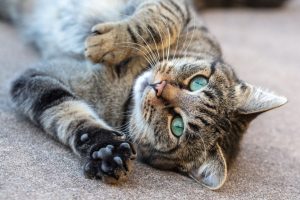Cats are beloved pets known for their playful antics and independent nature. One common behavior that cat owners may notice is their feline friend clawing at wood surfaces. But why do cats claw wood? Let’s explore the reasons behind this behavior and how you can address it.
Understanding the Behavior of Cats Clawing Wood
Instinctual Behavior:
Cats have a natural instinct to scratch and claw at surfaces, including wood, as a way to mark their territory. By leaving behind both a visual mark and a scent from the glands in their paws, cats are communicating to other animals that this area belongs to them. This behavior is deeply ingrained in a cat’s DNA, dating back to their days as wild hunters marking their territory in the wild.
Keeping Claws Healthy:
In addition to marking their territory, scratching on wood helps cats keep their claws healthy and sharp. When cats scratch, they are not only removing the dead outer layer of their claws but also stretching their muscles. This stretching is essential for maintaining their flexibility and overall claw health. Plus, regular scratching on rough surfaces like wood helps prevent their claws from becoming overgrown, which can be painful and inhibit their natural behaviors like hunting and grooming.
Tips for Encouraging Healthy Scratching Habits:
- Provide scratching posts: Offering a variety of scratching posts made of different materials such as sisal, carpet, and wood can help redirect your cat’s scratching behavior away from furniture.
- Placement is key: Put scratching posts in areas where your cat likes to scratch, such as near their favorite nap spot or by the window for a stimulating scratching experience.
- Positive reinforcement: Reward your cat with treats or praise when they use their scratching post to reinforce this positive behavior.
- Regular trimming: Keep your cat’s claws trimmed to prevent them from getting too long and causing discomfort.
- Consult a vet: If you notice excessive scratching or changes in your cat’s behavior, consult your vet to rule out any underlying health issues that may be causing this behavior.
By understanding and supporting your cat’s natural instincts to scratch on wood, you can provide them with an outlet for this behavior while keeping their claws healthy and your furniture intact.
Stress Relief:
Cats may scratch wood as a form of stress relief. Just like how humans might squeeze a stress ball or take a walk to clear their minds, cats need an outlet for their anxiety too. Scratching helps them release built-up tension and feel more relaxed. So, if your cat is clawing at wood, it may be their way of coping with stress. Providing them with appropriate scratching posts can help redirect this behavior in a positive way.
Environmental Enrichment:
Creating a cat-friendly environment is crucial for their overall well-being. Having suitable scratching surfaces like scratching posts or pads can enrich your cat’s environment and prevent them from ruining your furniture. Cats naturally need to scratch to stretch their muscles, mark their territory, and maintain their claws. By offering them appropriate outlets for scratching, you can keep both your cat and your home happy. Remember, different cats may prefer different materials for scratching, so it might take some trial and error to find the right fit for your feline friend.
- Place scratching posts strategically around your home: Cats love to scratch in various locations, so having scratching posts in different rooms can entice them to use these designated areas instead of your wood furniture.
- Incorporate vertical and horizontal scratching surfaces: Some cats prefer to scratch vertically, while others prefer horizontal surfaces. Providing both options can cater to your cat’s specific scratching preferences while protecting your belongings.
- Regularly trim your cat’s claws: Keeping your cat’s claws trimmed can help minimize damage caused by scratching. If you’re unsure how to do this, consider consulting with a veterinarian or a professional groomer for guidance.
Remember, understanding your cat’s natural behaviors and providing them with outlets for these behaviors is essential for a harmonious living environment. By incorporating these tips, you can help your feline friend satisfy their scratching instincts without sacrificing your furniture.
Training Tips:
Training your cat to avoid clawing at wood can be a challenging but rewarding process. Start by offering multiple scratching posts placed strategically around your home, especially near areas where your cat usually claws. Encourage your cat to use the posts by rubbing catnip on them or playing with interactive toys nearby. If you catch your cat clawing the wood furniture, redirect their behavior gently to the scratching post and reward them with treats or praise when they use it. Consistency is key in training, so be patient and persistent. Remember to trim your cat’s nails regularly to prevent them from causing damage unintentionally.
Helpful tip: Cats are more likely to scratch in areas where they feel comfortable and secure. Make sure to provide your cat with cozy resting spots and safe spaces in your home to reduce anxiety and the urge to claw at wood surfaces.
Deterrent Techniques:
When it comes to discouraging your cat from clawing at wood furniture, there are several effective deterrent techniques you can try. Cover the wood surfaces with double-sided tape or aluminum foil to make them less appealing to your cat. You can also use citrus-scented sprays or commercial deterrent sprays specifically designed to repel cats from scratching. Provide alternative surfaces like scratching pads or posts made of materials cats enjoy, such as sisal or cardboard. Regularly trim your cat’s nails to minimize the damage they can cause. Remember, patience and consistency are crucial when implementing deterrent techniques.
Helpful tip: Cats may be more prone to clawing at wood furniture if they are feeling stressed or anxious. Consider addressing their emotional needs, providing enrichment, and creating a calm environment to reduce their urge to scratch inappropriately.
Fun Facts About Cat Scratching Behavior
- Scratching is a natural instinct for cats and serves several purposes, including stretching their muscles, marking their territory with scent glands in their paws, and maintaining their claws’ sharpness.
- Cats may claw wood furniture out of boredom, anxiety, or the need for environmental stimulation. Providing them with engaging toys, scratching surfaces, and interactive playtime can help redirect this behavior.
- Cats have individual preferences when it comes to scratching surfaces. While some may prefer vertical scratching posts, others may enjoy scratching horizontally on rugs or mats. Experiment with different materials and styles to see what your cat prefers.
- Regular nail trimming, scratching post training, and environmental enrichment are essential for managing your cat’s scratching behavior effectively and maintaining a harmonious relationship with your feline friend. Remember, understanding your cat’s instincts and needs is key to preventing destructive scratching habits.
For more information on cat scratching behavior, you can visit the American Association of Feline Practitioners’ website for expert advice: AAFP Cat Friendly Homes.
Historical Significance:
Cats have a fascinating history of scratching and clawing at various surfaces. This behavior actually dates back to their wild ancestors who needed to mark their territory and keep their claws sharp for hunting. Scratching also helps cats stretch their bodies and flex their muscles, making it a natural and instinctual behavior for them. So, when your feline friend is scratching your favorite piece of wooden furniture, just remember they’re simply following their ancient instincts.
Different Types of Scratching Surfaces:
When it comes to scratching surfaces, cats have their preferences. Wood is a popular choice for many cats due to its texture and durability. It provides the right amount of resistance for them to sharpen their claws effectively. Additionally, the natural scent of wood may appeal to their senses, making it an attractive scratching material. Other surfaces like cardboard, carpet, and sisal are also common choices for scratching. So, if you’re looking to redirect your cat’s scratching behavior away from your wooden belongings, consider providing alternative surfaces like a scratching post covered in sisal or cardboard.
- Sisal: Cats love sisal due to its rough texture which helps them file down their claws.
- Cardboard: This material is great for scratching and shredding, giving cats a satisfying outlet for their natural behavior.
- Carpet: Some cats enjoy scratching carpeted surfaces, as it provides both resistance and comfort for their claws.
By understanding your cat’s preference for scratching surfaces and providing them with appropriate options, you can help prevent damage to your wooden furniture. Remember, a happy cat is one that has a designated scratching area that meets their needs.
Alex, a passionate animal lover, has experience in training and understanding animal behavior. As a proud pet parent to two dogs and three cats, he founded AnimalReport.net to share insights from animal experts and expand his knowledge of the animal kingdom.




